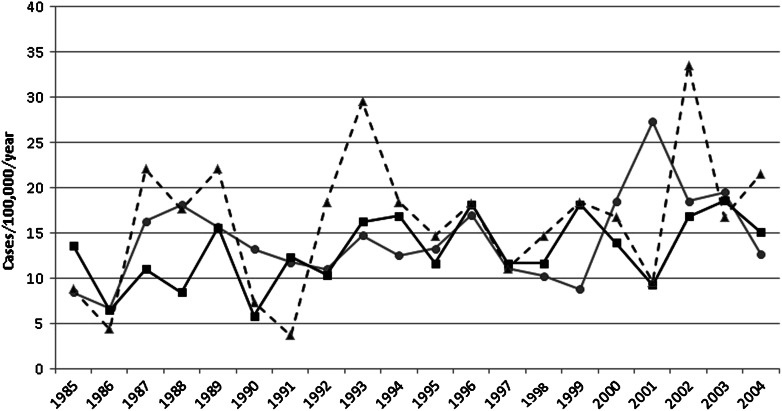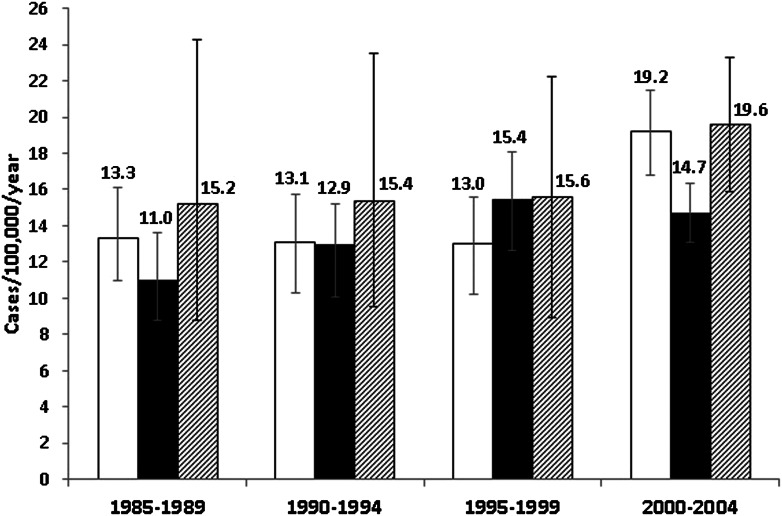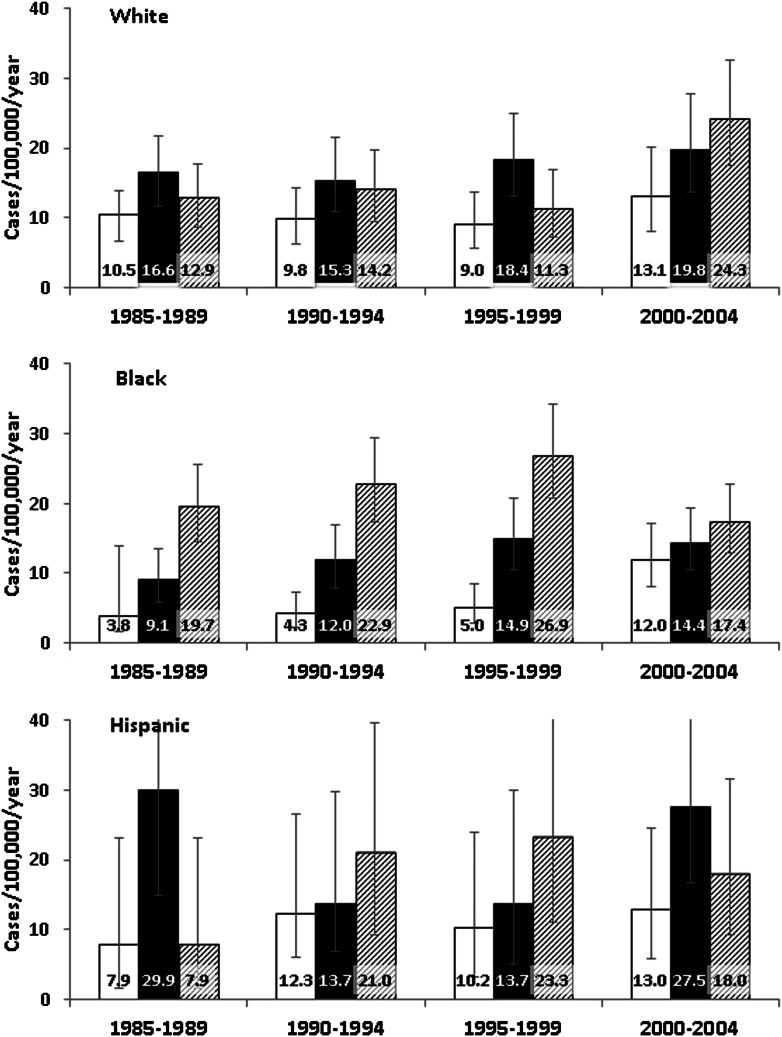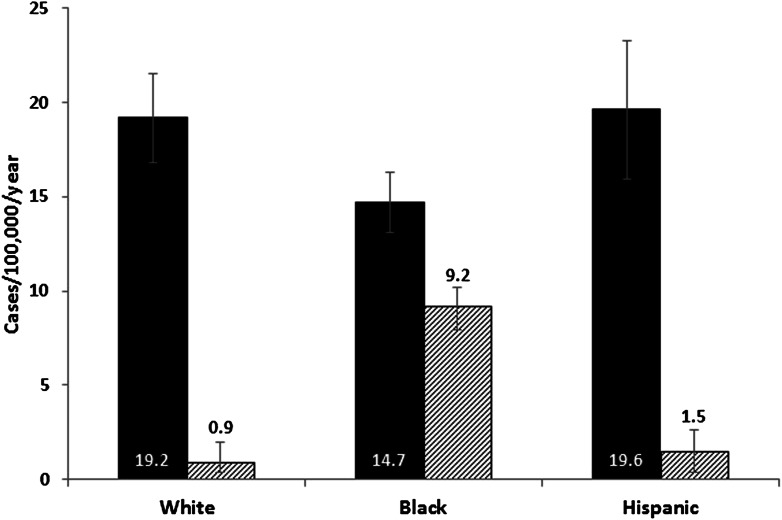Abstract
OBJECTIVE
The purpose of this study was to describe the incidence of type 1 diabetes in children in Philadelphia from 2000–2004, compare the epidemiology to the previous three cohorts in the Philadelphia Pediatric Diabetes Registry, and, for the first time, describe the incidence of type 2 diabetes.
RESEARCH DESIGN AND METHODS
Diabetes cases were obtained through a retrospective population-based registry. Hospital inpatient and outpatient records were reviewed for cases of type 1 and type 2 diabetes diagnosed from 1 January 2000 to 31 December 2004. The secondary source of validation was the School District of Philadelphia. Time series analysis was used to evaluate the changing pattern of incidence over the 20-year period.
RESULTS
The overall age-adjusted incidence rate in 2000–2004 of 17.0 per 100,000 per year was significantly higher than that of previous cohorts, with an average yearly increase of 1.5% and an average 5-year cohort increase of 7.8% (P = 0.025). The incidence in white children (19.2 per 100,000 per year) was 48% higher than in the previous cohort. Children aged 0–4 years had a 70% higher incidence (12.2 per 100,000 per year) than the original cohort; this increase was most marked in young black children. The overall age-adjusted incidence of type 2 diabetes was 5.8 per 100,000 per year and was significantly higher in black children.
CONCLUSIONS
The incidence of type 1 diabetes is rising among children in Philadelphia. The incidence rate has increased by 29% since the 1985–1989 cohort. The most marked increases were among white children ages 10–14 years and black children ages 0–4 years. The incidence of type 1 diabetes is 18 times higher than that of type 2 in white children but only 1.6 times higher in black children.
Population-based registries are the most comprehensive method to obtain complete data of disease incidence. In the 1990s, the World Health Organization (WHO) sponsored the DIAMOND Study (Diabetes Mondiale), a consortium of 150 pediatric diabetes registries worldwide using the same methodology and standardized criteria, which allowed for comparison among registries (1). U.S. registries from the WHO research group that published data over an extended time period included those from Allegheny County, Pennsylvania (2), Chicago (3), and Colorado (4). However, only the Philadelphia Pediatric Diabetes Registry has been continuously collecting and publishing incidence data on three racial/ethnic groups with type 1 diabetes since 1985. Beginning in 2002 and using different methodology (5), the SEARCH for Diabetes in Youth Study reported incidence data from 10 study locations in the U.S. for five racial/ethnic populations of children with diabetes. The EURODIAB (Europe and Diabetes) Study began in the 1980s and includes 44 European centers (6).
We are reporting on the fourth cohort, 2000–2004, of the Philadelphia Pediatric Diabetes Registry, which now contains 20 years of data; this richly diverse registry includes data from large populations of three racial groups. Whereas the first three cohorts (1985–1989, 1990–1994, and 1995–1999) had exclusively type 1 diabetes, data collection for the 2000–2004 cohort also included cases with type 2 diabetes. The Philadelphia Pediatric Diabetes Registry continues to be unique in its contribution of data on Hispanic children of Puerto Rican origin, reporting the first U.S. data for this population in the 1985–1989 cohort (7). Previous cohorts have demonstrated a very low incidence of type 1 diabetes in black children 0–4 years of age (7–9).
The purpose of this study was to determine the epidemiology of type 1 diabetes from 2000–2004; to determine the incidence by sex, racial/ethnic group, and age; and to compare these data with the previous cohorts to determine whether a temporal increase in incidence has occurred over 20 years. In addition, these data describe the first cohort of youth with type 2 diabetes in Philadelphia.
RESEARCH DESIGN AND METHODS
The methods for identifying cases of type 1 diabetes in the Philadelphia Pediatric Diabetes Registry have been described previously (7–9). Cases of type 2 diabetes were determined by reviewing diagnoses indicated on inpatient and outpatient medical records of the pediatric hospitals or by self-report in the data from schools. Designation of race/ethnicity was obtained from medical or school records. We report three racial/ethnic groups (white, black, Hispanic) as defined by the 2000 U.S. census. Philadelphia had a population of 322,998 children 0–14 years old. Black children comprised the majority at 53%, followed by non-Hispanic white children at 32% and Hispanic children at 13% of the population (11).
For the 2000–2004 cohort, the Philadelphia hospitals that admitted and followed >98% of the cases of pediatric diabetes were identified, and institutional review board permission to review records was obtained. The records of all children aged 0–14 years with a diagnosis code of type 1 or type 2 diabetes, and identified by hospital records or databases as having new onset between 1 January 2000 and 31 December 2004, were reviewed. Only children who resided in the city of Philadelphia at the time of diagnosis were included.
Although the standard of care for patients with newly diagnosed type 1 diabetes in Philadelphia continued to be hospital admission, inpatient admission of patients with newly diagnosed type 2 diabetes was less frequent. Therefore, both inpatient and outpatient records were abstracted for standard WHO diabetes registry criteria (1). In addition, data on length, height, weight, and BMI were collected for children ages 0–4 years.
As with the previous three cohorts, the completeness of the hospital registry was ascertained through a survey of nurses who staff all public, private, and parochial schools in the School District of Philadelphia. Approval from the research board of the School District of Philadelphia was obtained. To validate the hospital registry, parental consent was required to use cases of school children with diabetes. Completeness of the hospital registry was calculated through the capture-recapture method (10).
Age-adjusted incidence rates were calculated for the sample in general and for each subgroup (age, sex, and race) using 2000 Philadelphia census data (11). Age adjustment of the rates was done in 5-year intervals (0–4, 5–9, and 10–14 years) using the direct method with a standard population. Nonoverlapping confidence intervals were used as a conservative method to determine significant changes in age-adjusted rates from previously published cohorts.
Crude incidence rates and 95% CIs were calculated for each race and age group of children with both type 1 and type 2 diabetes over the current 5-year period. Poisson regression was used to test for differences between races and age groups in this cohort, and the Fisher exact rate ratio test was used to compare crude rates within age–race strata between cohorts. Finally, time series analysis was used to evaluate the changing pattern of the yearly incidence of type 1 diabetes over the entire period of 1985–2004.
RESULTS
Type 1 diabetes
The review of hospital records identified 273 children 0–14 years of age with newly diagnosed type 1 diabetes in Philadelphia from 2000–2004. School records with sufficient data for inclusion identified a total of 74 children diagnosed with type 1 diabetes from 2000–2004; 4 unduplicated cases (2 non-Hispanic white, 2 black) were identified from the school data, for a total of 277 cases from the combined hospital and school records. The ascertainment rate was calculated for the hospital records (95%), the secondary source (27%), and the combined registry of primary and secondary sources (96%). The total number of cases estimated using the capture-recapture method was 288. Non-Hispanic white children accounted for 36%, black children accounted for 46%, and Hispanic children accounted for 15% of the cases. Ten children of other races were included in the total. Of the cases identified, 54% were boys and 40% of cases were in the 10- to 14-year-old age group, 38% were 5–9 years old, and 22% were 0–4 years old.
The overall incidence rate from 2000–2004 was 17.2 per 100,000 per year (95% CI 15.2–19.3), and the age-adjusted incidence was 17.0 per 100,000 per year (95% CI 15.8–18.3) (Table 1). This incidence was significantly higher than that reported in 1985–1989 (13.4; 95% CI 11.7–15.3), 1990–1994 (13.3; 11.7–15.2), and 1995–1999 (14.8; 12.9–16.7) (7–9). The ascertainment-corrected incidence rate was 17.8 per 100,000 per year. In 2000–2004, there was a slightly higher incidence among boys, which is similar to previous cohorts, although the overall incidence had increased in both boys and girls (18.3 and 16.0, respectively). Over the 5 years of the study, the peak incidence occurred in 2002 (20.7) and the lowest rate occurred in 2001 (15.5).
Table 1.
Incidence of type 1 diabetes in children in Philadelphia from 2000–2004, by age and racial/ethnic group
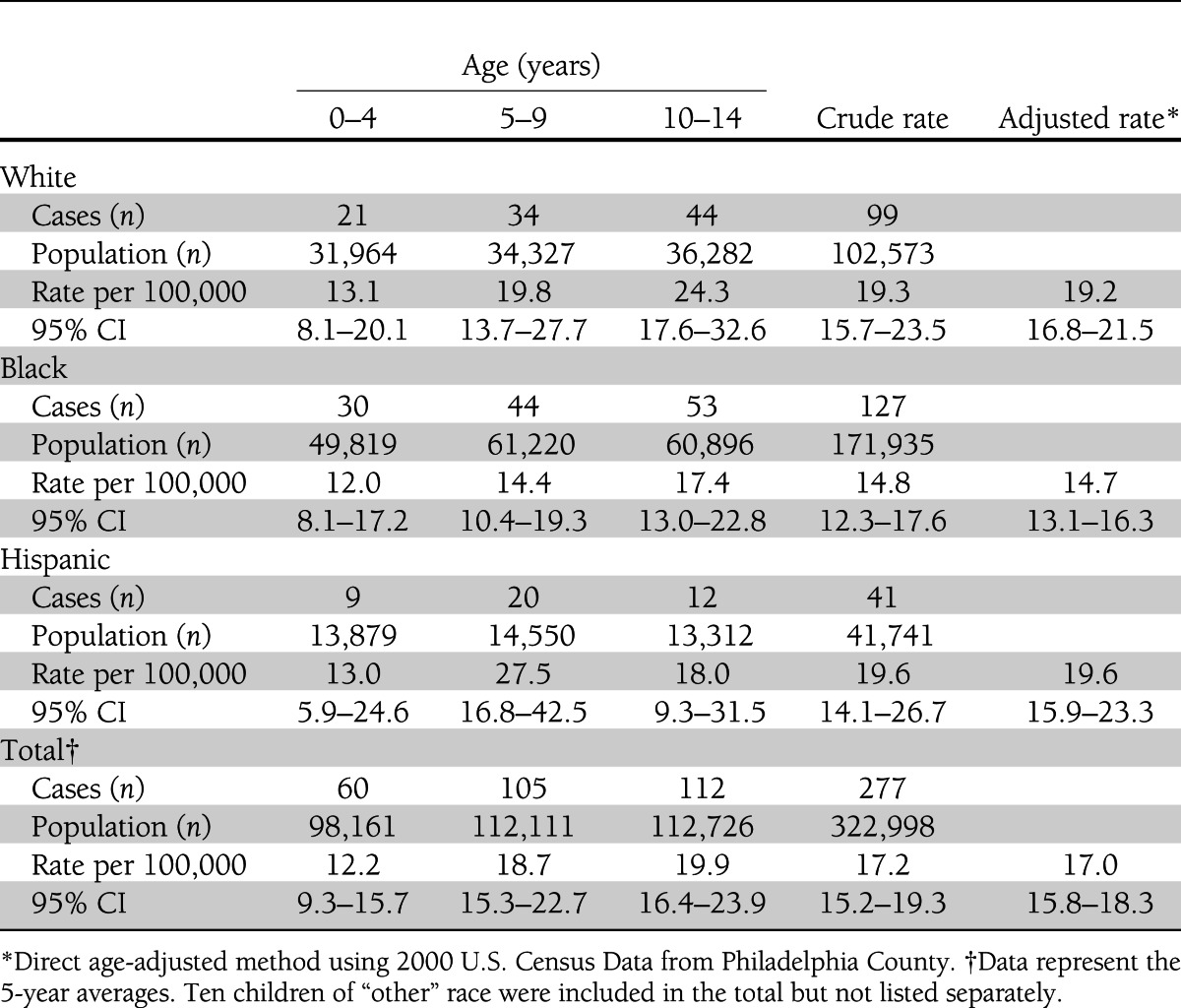
When analyzing by cohort, the overall incidence of type 1 diabetes in children in Philadelphia from 2000–2004 was 1.2 times higher than the 1995–1999 cohort and has increased by 1.3-fold, or 29%, since the 1985–1989 cohort. This corresponds to an average 5-year increase of 7.8%, or a yearly increase of 1.5%, under a linear trend model (P = 0.025) (Fig. 1).
Figure 1.
Incidence of type 1 diabetes by race/ethnicity and year. Gray line = white children; black line = black children; dashed line = Hispanic children.
The overall incidence by age group for 2000–2004 was 12.2 (95% CI 9.3–15.7) in children 0–4 years old, 18.7 (15.3–22.7) in children 5–9 years old, and 19.9 (16.4–23.9) in youth 10–14 years old. The incidence of type 1 diabetes had been stable in the youngest age group at approximately 7.3 per 100,000 per year in the first three cohorts, but the 2000–2004 cohort demonstrated a significant (P = 0.016) 70% increase among children 0–4 years of age. The incidence rate increased across the age groups: 10–14 year olds had a significantly higher incidence than 0–4 year olds. Compared with the previous cohort, the distribution of cases by age group showed a higher percentage of cases in young children (0–4 years old; 22% vs. 18% of cases) and a decrease in the percentage of cases in the 10- to 14-year-old age group (45% vs. 40% of cases) (8).
The racial/ethnic data demonstrated that the highest age-adjusted rate was in Hispanic children (19.6; 95% CI 15.9–23.3), followed by non-Hispanic whites (19.2 [16.8–21.5]) and blacks (14.7 [13.1–16.3]). Analysis of the racial/ethnic data across the four cohorts (Fig. 2) showed that the incidence in white children had been very stable historically at approximately 13.0 per 100,000 per year. However, there was a significant 48% increase in the 2000–2004 cohort over the 1995–1999 cohort. For the first time, the incidence in white children approached the incidence in Hispanics. Similarly, Hispanic children previously had been very stable at 15.5 per 100,000 per year, but a 27% increase was seen in this cohort. Although in the 1995–1999 cohort, the incidence in black children surpassed white children for the first time, in the 2000–2004 cohort the incidence in black children was again lower than in white children. The yearly incidence rates for the entire 1985–2004 period also were analyzed. There was an overall rise in the incidence rates for the total group of children from one year to the next (P < 0.001), but racial/ethnic differences over time were not significant (P = 0.10). Stratifying by race, time series methods showed the only significant increasing linear trend over time was in black children (χ2 = 8.39; P = 0.004), with an approximate 2.3% yearly increase in the incidence of type 1 diabetes. No other significant seasonal effects (all P > 0.1) or linear trends over time (white: P = 0.69, Hispanic: P = 0.07) were found.
Figure 2.
Age-adjusted incidence rates for type 1 diabetes in four cohorts, 1985–2004. □ = white children; ■ = black children; ▨ = Hispanic children.
Figure 3 shows the racial/ethnic differences by age group across the four cohorts. A 115% increase in incidence from the 1995–1999 cohort (11.3; 95% CI 7.3–16.9) to the 2000–2004 cohort (24.3 [7.6–32.6]) (P = 0.003) occurred in 10- to 14-year-old white children. The incidence of type 1 diabetes in children 0–4 years of age rose most strikingly in black children in 2000–2004 (12.0 [8.1–17.2]) compared with 1995–1999 (5.0 [2.8–8.4]) (P = 0.008); this is a 2.5-fold rise since the 1995–1999 cohort and a threefold rise (from 3.8 in the 1985–1989 cohort) during the 20 years of the registry. BMI frequencies/distribution were examined for the total 0–4 year age group by race and compared with the 1995–1999 cohort. The mean BMI z score for the 1995–1999 cohort was 1.2 ± 1.0 and was 0.6 ± 1.5 for the 2000–2004 cohort; no statistical difference was found in the distribution of BMI z scores for the two cohorts (P = 0.290).
Figure 3.
Incidence of type 1 diabetes by age and racial/ethnic group (white [top], black [middle], and Hispanic [bottom]) in four cohorts, 1985–2004. □ = 0–4 years old; ■ = 5–9 years old; ▨ = 10–14 years old.
Type 2 diabetes
A total of 96 cases were identified as being diagnosed with type 2 diabetes from 2000–2004 in Philadelphia. The review of hospital records identified 94 cases, and school records with sufficient data identified a total of 20 children diagnosed from 2000–2004, two of whom had not been identified in the hospital registry. The ascertainment rate was calculated for the hospital registry (90%), the secondary source (19%), and the combined registry of the primary and secondary sources (92%). The capture-recapture method estimated a total of 104 subjects (10). Black children accounted for 85.4% of the cases, non-Hispanic white children comprised 5.2%, Hispanic children comprised 3.1%, and 4.1% were of other ethnicity. Overall, the age-adjusted incidence rate (Table 2) was 5.8 per 100,000 per year, with the highest incidence observed in black children (9.2; 95% CI 7.9–10.2), followed by Hispanic children (1.5 [0.4–2.6]) and non-Hispanic whites (0.94 [0.4–2.0]). Type 1 diabetes was 18 times more common than type 2 diabetes in white children, 10 times more common in Hispanic children, but only 1.6 times more common in black children (Fig. 4). The incidence rate for type 2 diabetes was significantly higher in girls (9.3 [7.3–11.7]) than boys (2.7 [1.7–4.1]) (P < 0.001).
Table 2.
Incidence of type 2 diabetes in children in Philadelphia from 2000–2004, by age and racial/ethnic group
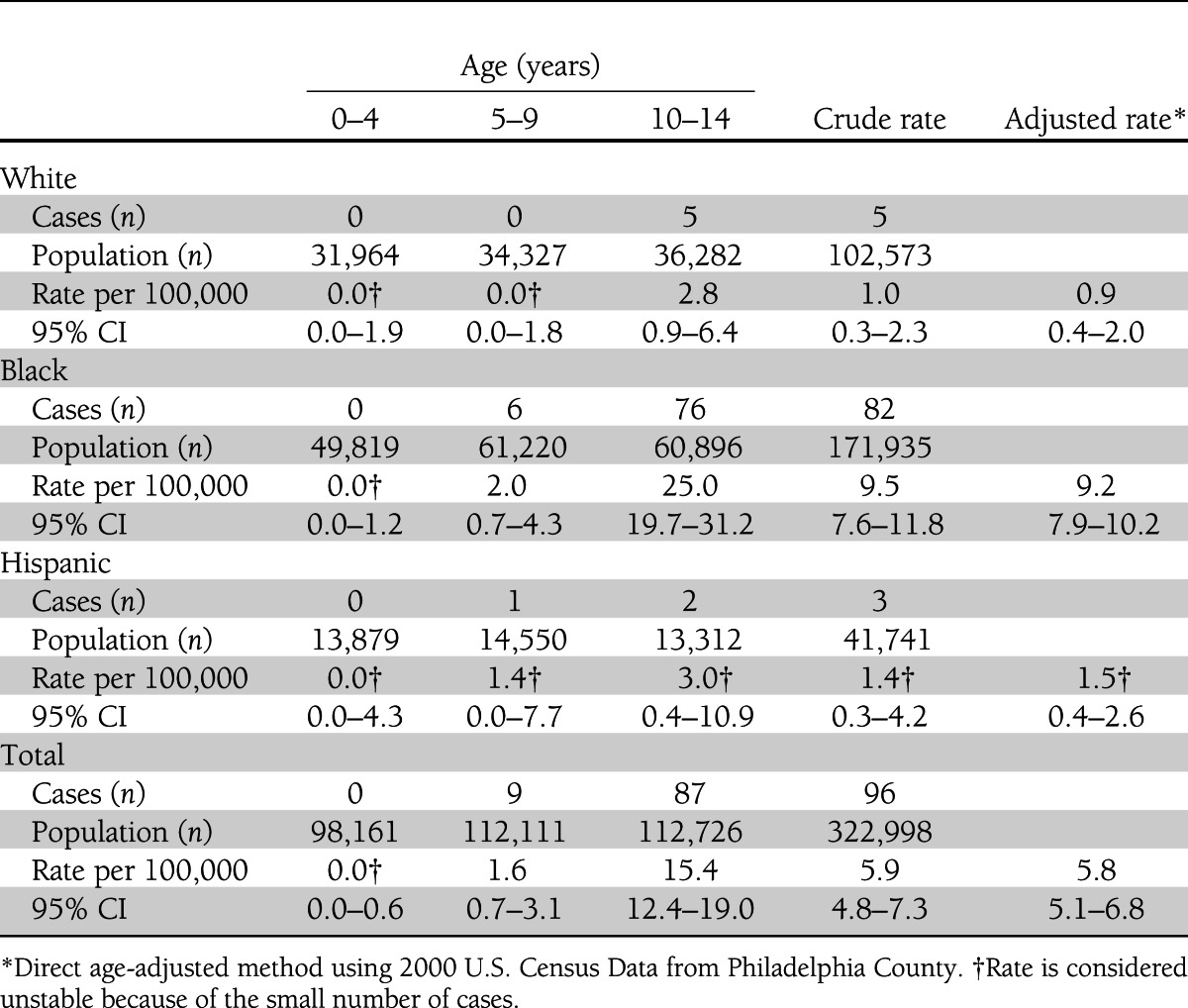
Figure 4.
Age-adjusted incidence rates for type 1 (■) vs. type 2 (▨) diabetes by racial/ethnic group.
When analyzing incidence by age, the incidence of type 2 diabetes in the 10- to 14-year-old age group (15.4 per 100,000 per year [95% CI 12.4–19.0]) was significantly higher than the incidence in the younger age groups (P = 0.001): 1.6 (0.7–3.1) for children 5–9 years old and 0.0 (0.0–0.6) for children 0–4 years old. Although the incidence of type 1 diabetes was higher in boys in all races, the rate of type 2 diabetes was four times higher in black girls (15.4 vs. 3.9). When data were analyzed by age and race, the incidence of type 2 diabetes in black children 10–14 years of age was 25 per 100,000 per year (19.7–31.2) and the incidence of type 1 diabetes was 17.4 (13.0–22.8).
CONCLUSIONS
In the 20 years of the Philadelphia Pediatric Diabetes Registry, 935 cases of type 1 diabetes have been identified. We conclude that the overall incidence of type 1 diabetes among children in Philadelphia in 2000–2004 was significantly higher than in previous cohorts. The incidence of type 1 diabetes has increased at an average yearly rate of 1.5%, or an average 5-year cohort rate of 7.3%, over 20 years. However, the incidence had been relatively stable over the first 15 years and has risen most markedly since the 1995–1999 cohort. These are the only U.S. pediatric registry data collected continuously during that 20-year time period. The incidence of type 1 diabetes was stable in Chicago from 1994–2003 (3). However, the Colorado registry found an increase of 2.3% per year over 27 years. Although there were no incidence data collected in Colorado from 1989–2001 (4), these data are most comparable to the Philadelphia registry. The SEARCH for Diabetes in Youth Study includes only Colorado as a site that was a member of the registry consortium from the 1980s. SEARCH data do not include incidence rates before 2002 and therefore cannot be used as a comparison for temporal trends. This upward trend in incidence of type 1 diabetes in children in Philadelphia adds to the evidence of an increasing incidence of diabetes in the U.S. and worldwide (4,6).
There has been a similar significant rise in diabetes during our registry period throughout most of Europe and Scandinavia (average annual increase, 3.9%) (6). When looking at diabetes trends in the Western Hemisphere, it is interesting that Brazil, with a low incidence of type 1 diabetes in the 1980s (2.8 per 100,000 per year) had the highest annual increase for 20 years (27.5%) (12). Northern provinces in Canada with an initial high incidence (35 per 100,000 per year) had a much lower annual increase of 0.78 during this time period (13).
The incidence of type 1 diabetes among children has increased in all racial/ethnic groups in Philadelphia over 20 years. The 2000–2004 incidence in black children was 44% higher than that of the first Philadelphia cohort (1985–1989) and higher than the incidence reported by Chicago (3) but similar to the rate reported by SEARCH (14). The highest incidence by racial/ethnic group in Philadelphia always has been in Hispanic children, and the incidence in Hispanic children in Philadelphia is higher than that reported by others over a similar time period (3,4,15). However, the population of Hispanic children in Philadelphia is largely of Puerto Rican origin, and a similarly high incidence of type 1 diabetes has been reported from the registry in Puerto Rico (16). The greatest increase in incidence by race in Philadelphia was among white children. There has been a rise in incidence among white children of each age group, but the most significant increase has been in white children 10–14 years of age, in whom the incidence of type 1 diabetes has doubled since the 1995–1999 cohort. The incidence (24.3 per 100,000 per year) in non-Hispanic white youth 10–14 years old in Philadelphia was similar to the rate found in Colorado (23.4) (4) and Chicago (23.9) (3) and not significantly different than the rate of 27.9 reported by SEARCH (17).
The incidence of type 1 diabetes among children 0–4 years of age in Philadelphia increased by 70% over the 20 years of the study. A similar sharp rise in incidence in children 0–4 years of age was found in data from the Colorado (4), EURODIAB (6), Israel (18), and Finland (19) registries. EURODIAB has seen a rapid rise in rates for 0- to 4-year-old children, predicting that the number of new cases in children younger than 5 years will double between 2005 and 2020 (6). The rate of progression from autoimmunity to onset of diabetes over the last 20 years was studied by Ziegler et al. (20). They found that, of the more recent cohort of children born between 2004 and 2010, children younger than 4 years had a significantly more rapid progression to diabetes presentation compared with an older cohort born between 1989 and 2000, despite both groups having a similar prevalence of islet autoantibodies. This finding could help to account for the rising incidence of type 1 diabetes in young children. In previous cohorts, there was a significant difference in incidence between the 10- to 14-year-old age group when compared with both the 5- to 9- and 0- to 4-year-old age groups. With the increased incidence in the 0- to 4-year-old age group, incidence rates for age groups are converging. EURODIAB has found a similar convergence of incidence rates, predicting that this convergence will narrow further by 2020 (6). Perhaps the most interesting finding in the 2000–2004 Philadelphia cohort of young children was the rise in the incidence of type 1 diabetes among black children 0–4 years of age, an increase of 140% since the 1995–1999 cohort and an increase of more than 200% over 20 years. We (7–9) and others (2) previously have demonstrated the low incidence in this population, suggesting possible protective factors.
The accelerator hypothesis has received attention as a possible explanation for the rising incidence of type 1 diabetes in young children. This hypothesis is based on the premise that insulin resistance in the presence of obesity is a characteristic of both type 1 and type 2 diabetes set in the context of different genetic and environmental backgrounds. Therefore, higher environmental pressure from changing lifestyle habits would predict that a child with a higher BMI would experience acceleration of β-cell decline and younger age at the onset of diabetes (21). However, neither the Philadelphia data nor the SEARCH data demonstrated an elevated BMI associated with the increased incidence seen in children 0–4 years old (22). The hygiene hypothesis proposes that decreased exposure to infectious agents at a young age results in an immaturity of the immune system and an increase in immune-modulated disorders (23). Other environmental factors that have been put forth to elucidate the increase of type 1 diabetes in young children include an increase in vitamin D deficiency (24) and an increase in early exposure to cow’s milk (25).
Our data on type 2 diabetes in youth are among the few from a population-based registry and the first cohort reported in Philadelphia. With the exception of SEARCH (2007), and Chicago (3) (cases identified as non-type 1 diabetes) studies of the epidemiology of type 2 diabetes in the U.S. have been largely case series. Type 1 diabetes continues to be the greatest risk for children in Philadelphia (three times greater than type 2 diabetes). The overall annual incidence rate of type 2 diabetes in children from 2000–2004 was 5.9 (95% CI 4.8–7.3). This was significantly higher than the overall rate of 2.8 (2.2–3.4) in the SEARCH registry for children 0–14 years old of the same racial/ethnic groups (5). Of note is that the number of cases of type 2 diabetes in Philadelphia was small, and data should be interpreted with caution.
Similar to others’ findings (3,5), our data showed that the incidence rate for type 2 diabetes was higher in girls than boys and was highest in African American youth and lowest in non-Hispanic white youth. The rate of type 2 diabetes in Hispanic children was lower in Philadelphia than in the SEARCH registry possibly because of the difference in country of origin of the population or under-ascertainment of Hispanic children with diabetes in Philadelphia. The incidence rates of type 2 diabetes in Philadelphia is likely to be conservative and underestimated because hospital registries are insufficient to identify all cases of type 2 diabetes and children with type 2 diabetes may not self-identify in schools (the secondary source of validation).
There are some limitations to the Philadelphia Pediatric Diabetes Registry. Data were collected from the three pediatric hospitals in Philadelphia. In addition to the pediatric facilities, there are 2 hospitals with pediatric units in Philadelphia. The pediatric hospitals accounted for >98% of the cases of children with diabetes in the previous cohort (9), and this was verified for this sample as well. Furthermore, some of the few cases that were diagnosed in a general hospital and subsequently transferred to a pediatric hospital were then identified. Any additional cases also could have been captured by the secondary source of validation. Another limitation is that it was not possible to positively confirm the type of diabetes of the cases. All hospitals providing cases to this registry obtained autoantibodies from children with newly diagnosed diabetes that may have aided in correctly identifying the type of diabetes. However, we acknowledge that the classification of diabetes is not straightforward and misclassification is possible. Some cases of type 1 diabetes will not have autoantibodies at onset and a number of cases of type 2 diabetes will have antibodies. In addition, there are children with diabetes who have monogenic diabetes or other types that fall into neither category of type 1 nor type 2 diabetes (26). Another limitation of our registry was that data on BMI z scores were not available for cohorts before 1995–1999, making 20-year comparisons impossible. It is unlikely that misclassification is the cause for our most important findings: the marked increase in incidence of type 1 diabetes in white children 10–14 years of age and black children 0–4 years of age.
A major strength of the Philadelphia registry is the availability of longitudinal, continuous data collected in the same geographical area with the same methods of case ascertainment. We have been able to maintain this registry continuously since 1985. Almost all cases are admitted to one of Philadelphia’s children’s hospitals at diagnosis, and we have sustained an ongoing relationship with the Philadelphia school system as a secondary source of validation. Philadelphia data are crucial in observing trends over time in a racially/ethnically diverse population with large numbers of white, black, and Hispanic children. In addition, the Philadelphia registry is the only registry currently collecting data in the northeastern region of the U.S.
Type 1 diabetes is increasing in Philadelphia and worldwide (27). The most rapid increase in type 1 diabetes is in children diagnosed before age 5. These young children are at the highest risk for mortality because of delayed diagnosis (28). The rapidly rising risk of diabetes in black children 0–4 years of age is of particular concern in view of the marked racial disparities that have been identified in diabetes outcomes and treatment (29–33).
It is critical to continue to investigate risk factors that may be associated with the increased incidence of type 1 diabetes overall and the marked rise in the incidence in young children. Improving and continuing surveillance systems will help elucidate the etiology of this alarming worldwide trend in pediatric diabetes.
Acknowledgments
No potential conflicts of interest relevant to this article were reported.
T.H.L. researched data, contributed to the discussion, and wrote, reviewed, and edited the manuscript. L.E.L.K., S.J.R., and C.J.H. contributed to the discussion and wrote, reviewed, and edited the manuscript. K.M.M., I.R., and E.S. researched data, contributed to the discussion, and reviewed and edited the manuscript. A.A. and S.F. researched data and contributed to the discussion. T.H.L. is the guarantor of this work and, as such, had full access to all the data in the study and takes responsibility for the integrity of the data and the accuracy of the data analysis.
Preliminary data were presented at the 69th Scientific Sessions of the American Diabetes Association, New Orleans, Louisiana, 5–9 June 2009.
The authors are grateful for the collaboration of the nurses from the School District of Philadelphia. They also thank Emily Watts, from the University of Pennsylvania School of Nursing, for help with the preparation of the manuscript.
References
- 1.WHO DIAMOND Project Group WHO Multinational Project for Childhood Diabetes. Diabetes Care 1990;13:1062–1068 [DOI] [PubMed] [Google Scholar]
- 2.Libman IM, LaPorte RE, Becker D, Dorman JS, Drash AL, Kuller L. Was there an epidemic of diabetes in nonwhite adolescents in Allegheny County, Pennsylvania? Diabetes Care 1998;21:1278–1281 [DOI] [PubMed] [Google Scholar]
- 3.Smith TL, Drum ML, Lipton RB. Incidence of childhood type I and non-type 1 diabetes mellitus in a diverse population: the Chicago Childhood Diabetes Registry, 1994 to 2003. J Pediatr Endocrinol Metab 2007;20:1093–1107 [DOI] [PubMed] [Google Scholar]
- 4.Vehik K, Hamman RF, Lezotte D, et al. Increasing incidence of type 1 diabetes in 0- to 17-year-old Colorado youth. Diabetes Care 2007;30:503–509 [DOI] [PubMed] [Google Scholar]
- 5.The Writing Group for the SEARCH for Diabetes in Youth Study Group Incidence of diabetes in youth in the United States. JAMA 2007;297:2716–2724 [DOI] [PubMed] [Google Scholar]
- 6.Patterson CC, Dahlquist GG, Gyürüs E, Green A, Soltész G, EURODIAB Study Group Incidence trends for childhood type 1 diabetes in Europe during 1989-2003 and predicted new cases 2005-20: a multicentre prospective registration study. Lancet 2009;373:2027–2033 [DOI] [PubMed] [Google Scholar]
- 7.Lipman TH. The epidemiology of type I diabetes in children 0-14 yr of age in Philadelphia. Diabetes Care 1993;16:922–925 [DOI] [PubMed] [Google Scholar]
- 8.Lipman TH, Chang Y, Murphy KM. The epidemiology of type 1 diabetes in children in Philadelphia 1990-1994: evidence of an epidemic. Diabetes Care 2002;25:1969–1975 [DOI] [PubMed] [Google Scholar]
- 9.Lipman TH, Jawad AF, Murphy KM, et al. Incidence of type 1 diabetes in Philadelphia is higher in black than white children from 1995 to 1999: epidemic or misclassification? Diabetes Care 2006;29:2391–2395 [DOI] [PubMed] [Google Scholar]
- 10.Bruno G, LaPorte RE, Merletti F, Biggeri A, McCarty D, Pagano G. National diabetes programs. Application of capture-recapture to count diabetes? Diabetes Care 1994;17:548–556 [DOI] [PubMed] [Google Scholar]
- 11.U.S. Census Bureau. Census 2000 Summary for Philadelphia County, Pennsylvania [database online]. Available from http://censtats.census.gov/pub/Profiles.shtml Accessed 8 July 2011
- 12.Negrato CA, Dias JP, Teixeira MF, et al. Temporal trends in incidence of type 1 diabetes between 1986 and 2006 in Brazil. J Endocrinol Invest 2010;33:373–377 [DOI] [PubMed] [Google Scholar]
- 13.Newhook LA, Grant M, Sloka S, et al. Very high and increasing incidence of type 1 diabetes mellitus in Newfoundland and Labrador, Canada. Pediatr Diabetes 2008;9:62–68 [DOI] [PubMed] [Google Scholar]
- 14.Mayer-Davis EJ, Beyer J, Bell RA, et al. ; SEARCH for Diabetes in Youth Study Group Diabetes in African American youth: prevalence, incidence, and clinical characteristics: the SEARCH for Diabetes in Youth Study. Diabetes Care 2009;32(Suppl. 2):S112–S122 [DOI] [PMC free article] [PubMed] [Google Scholar]
- 15.Lawrence JM, Mayer-Davis EJ, Reynolds K, et al. SEARCH for Diabetes in Youth Study Group Diabetes in Hispanic American youth: prevalence, incidence, demographics, and clinical characteristics: the SEARCH for Diabetes in Youth Study. Diabetes Care 2009;32(Suppl. 2):S123–S132 [DOI] [PMC free article] [PubMed] [Google Scholar]
- 16.Frazer de Llado TE, Gonzalez de Pijem L, Hawk B, Puerto Rican IDDM Coalition Incidence of IDDM in children living in Puerto Rico. Diabetes Care 1998;21:744–746 [DOI] [PubMed] [Google Scholar]
- 17.Bell RA, Mayer-Davis EJ, Beyer JW, et al. SEARCH for Diabetes in Youth Study Group Diabetes in non-Hispanic white youth: prevalence, incidence, demographics, and clinical characteristics: the SEARCH for Diabetes in Youth Study. Diabetes Care 2009;32(Suppl. 2):S102–S111 [DOI] [PMC free article] [PubMed] [Google Scholar]
- 18.Sella T, Shoshan A, Goren I, et al. A retrospective study of the incidence of diagnosed type 1 diabetes among children and adolescents in a large health organization in Israel, 2000-2008. Diabet Med 2011;28:48–53 [DOI] [PubMed] [Google Scholar]
- 19.Harjutsalo V, Sjöberg L, Tuomilehto J. Time trends in the incidence of type 1 diabetes in Finnish children: a cohort study. Lancet 2008;371:1777–1782 [DOI] [PubMed] [Google Scholar]
- 20.Ziegler AG, Pflueger M, Winkler C, et al. Accelerated progression from islet autoimmunity to diabetes is causing the escalating incidence of type 1 diabetes in young children. J Autoimmun 2011;37:3–7 [DOI] [PMC free article] [PubMed] [Google Scholar]
- 21.Wilkin TJ. The accelerator hypothesis: weight gain as the missing link between type I and type II diabetes. Diabetologia 2001;44:914–922 [DOI] [PubMed] [Google Scholar]
- 22.Dabelea D, D’Agostino RB, Jr, Mayer-Davis EJ, et al. SEARCH for Diabetes in Youth Study Group Testing the accelerator hypothesis: body size, β-cell function, and age at onset of type 1 (autoimmune) diabetes. Diabetes Care 2006;29:290–294 [DOI] [PubMed] [Google Scholar]
- 23.Gale EAM. A missing link in the hygiene hypothesis? Diabetologia 2002;45:588–594 [DOI] [PubMed] [Google Scholar]
- 24.The EURODIAB Substudy 2 Study Group. Vitamin D supplement in early childhood and risk for type I (insulin-dependent) diabetes mellitus. Diabetologia 1999;42:51–54 [DOI] [PubMed] [Google Scholar]
- 25.Vaarala O, Knip M, Paronen J, et al. Cow’s milk formula feeding induces primary immunization to insulin in infants at genetic risk for type 1 diabetes. Diabetes 1999;48:1389–1394 [DOI] [PubMed] [Google Scholar]
- 26.Libman IM, Pietropaolo M, Arslanian SA, LaPorte RE, Becker DJ. Evidence for heterogeneous pathogenesis of insulin-treated diabetes in black and white children. Diabetes Care 2003;26:2876–2882 [DOI] [PubMed] [Google Scholar]
- 27.Stanescu DE, Lord K, Lipman TH. The epidemiology of type 1 diabetes in children. Endocrinol Metab Clin North Am 2012;41:679–694 [DOI] [PubMed] [Google Scholar]
- 28.Wolfsdorf J, Glaser N, Sperling MA, American Diabetes Association Diabetic ketoacidosis in infants, children, and adolescents: a consensus statement from the American Diabetes Association. Diabetes Care 2006;29:1150–1159 [DOI] [PubMed] [Google Scholar]
- 29.Lipton R, Good G, Mikhailov T, Freels S, Donoghue E. Ethnic differences in mortality from insulin-dependent diabetes mellitus among people less than 25 years of age. Pediatrics 1999;103:952–956 [DOI] [PubMed] [Google Scholar]
- 30.Centers for Disease Control and Prevention (CDC) Racial disparities in diabetes mortality among persons aged 1–19 years--United States, 1979–2004. MMWR Morb Mortal Wkly Rep 2007;56:1184–1187 [PubMed] [Google Scholar]
- 31.Valenzuela JM, La Greca AM, Hsin O, Taylor C, Delamater AM. Prescribed regimen intensity in diverse youth with type 1 diabetes: role of family and provider perceptions. Pediatr Diabetes 2011;12:696–703 [DOI] [PubMed] [Google Scholar]
- 32.Lipman TH, Willi S, Miller KW, Beck RW. Racial disparities in insulin pump therapy and hemoglobin A1C (HbA1C) among children with type 1 diabetes (T1D) enrolled in the T1D Exchange Clinic Registry (Abstract). Pediatr Diabetes 2011;12:27 [Google Scholar]
- 33.Petitti DB, Klingensmith GJ, Bell RA, et al. SEARCH for Diabetes in Youth Study Group Glycemic control in youth with diabetes: the SEARCH for Diabetes in Youth Study. J Pediatr 2009;155:668–672, e1–e3 [DOI] [PMC free article] [PubMed] [Google Scholar]



